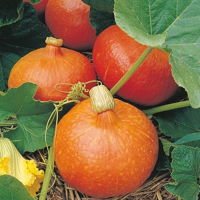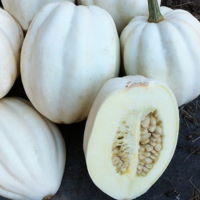Squash - Winter
Type: Vegetable
Rotation Group: 0, No rotation needed
 | | HONEY BEARWe feel this may be the best tasting acorn squash you can grow. The 10cm (4in) fruits are just right as individual portions. They have a delightfully sweet flavour and are produced on compact, powdery mildew-resistant plants. Children will enjoy this variety. |
 | | TURKS TURBANThe distinctive shape and colouration of this variety may seem more ornamental than edible, but Turks Turban is a delicious winter squash for baking, steaming or turning into soup. The trailing plants produce fruits up to 30cm/12in across, the flesh of which is sweet and golden orange. This variety is also a fine keeper. |
 | | UCHIKI KURIAn onion-shaped squash with orange skin and flesh with a good flavour. Early to mature and a very good keeping variety. |
 | | MASHED POTATOThe plants are vigorous in growth, producing on average 5-6 fruits per plants. The bright white squashes hold their colour well and has soft buttery flesh which can be roasted and mashed for a delicious, low calorie alternative to potatoes. |
Site, Soil and Preparation
Squash require a well drained, humus rich soil in full sun, with shelter from winds.
Indoor Sowing
Sow squash seed indoors from April to May for transplanting later on. Sow pumpkins seeds on their sides in small 7.5cm (3”) pots of seed compost at a depth of about 2.5cm (1”). Place in a propagator or seal pots inside a plastic bag at a temperature of 20-25C (68-77F) until germination which takes 5-7 days. Do not exclude light, as this helps germination. Once germinated, grow pumpkins on in cooler conditions until all risk of frost has passed and pumpkin plants are large enough to be transplanted outdoors. Gradually acclimatise them to outdoor conditions over 7 - 10 days before planting pumpkins outdoors.
Outdoor Sowing
Alternatively direct sow squash outdoors from late May to June at a depth of 2.5cm (1”) and a distance of 2m (6 1/2’) - 3m (10’) apart depending on the variety. Sow 2 seeds per hole and thin out the weakest seedling per station after germination.
Thinning
Thin plants during transplantation to final growing position.
Transplanting
Transplant squash outdoors in warm, well drained, humus rich soil in full sun, with shelter from winds. Choose a spot that receives at least 6 hours of direct sun per day.
Care
Feed and water squash regularly. When growing squash, a thick mulch of organic matter spread around the plants will help to conserve moisture at the roots. Hoe between plants regularly to prevent weeds from establishing. Squash will begin to produce long stems which can be trained in a circle around the plant to prevent them spreading too far.
Harvest
Leave squash on the plant for as long as possible until the skin has hardened and the fruits start to crack near to the stem. Harvest pumpkins before the first frosts by cutting each fruit from the stem leaving several inches of the stem attached.





